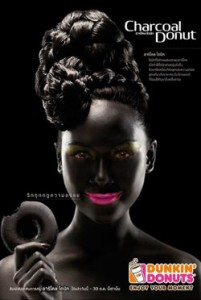A ‘blackfaced’ model appearing in a Dunkin’ Donuts ad campaign in Thailand has stirred up worldwide controversy for the coffee giant . In this video ad for the new charcoal donut, a model is shown covered in black paint; an image that some, particularly Americans, find offensive. (Print ad below)
While the American Branch of Dunkin’ Donuts immediately apologized for the ‘insensitive’ ad, CEO Nadim Salhani of Dunkin’ Donuts Thailand is saying, ‘so what?’ calling the opposition to the ad “paranoid American thinkers.” In this article, Salhani asks the question, “what if the product was white and I painted someone white? Would that be racist?”
In my opinion, the backlash that resulted from this campaign is ludicrous. The ad does not contain any actual reference to black people or black culture, only a new charcoal donut – yet influential social rights groups such as Human Rights Watch are strongly opposing the campaign. The group’s deputy Asia Director Phil Robertson, speaking to the Associated Press, claimed in this article that, “It’s both bizarre and racist that Dunkin’ Donuts thinks that it must color a woman’s skin black and accentuate her lips with bright pink lipstick to sell a chocolate doughnut.” As far as I’m concerned, the only part of this ordeal that is ‘bizarre’ is that a charcoal donut marketing campaign became a racial matter.
While the apology on behalf of the American branch of Dunkin’ should be unnecessary, it’s a strategic move. Any media reports of American Dunkin’ Donuts being associated with racism – regardless of the company’s actual stance on racism – is a public relations catastrophe.
It is unfortunate that the critics of this campaign are narrow-minded and can not let go of the archaic connotations of blackface. It is this type of antiquated thinking that will allow racism to remain prevalent in society. Morgan Freeman sums it up best in this interview: when asked how he thinks we should put a stop to racism, he replies “stop talking about it.”

